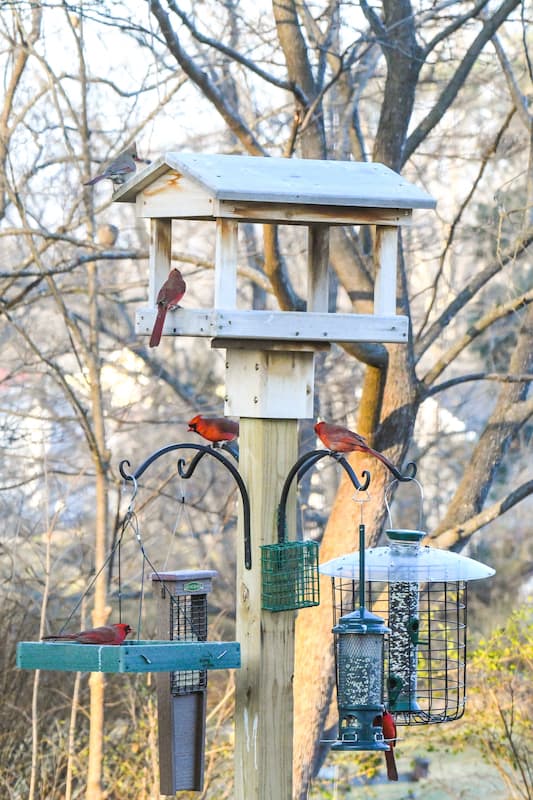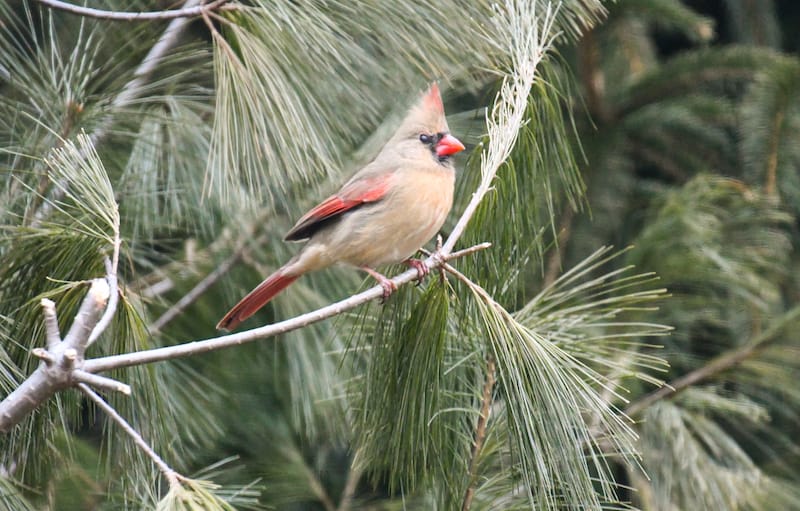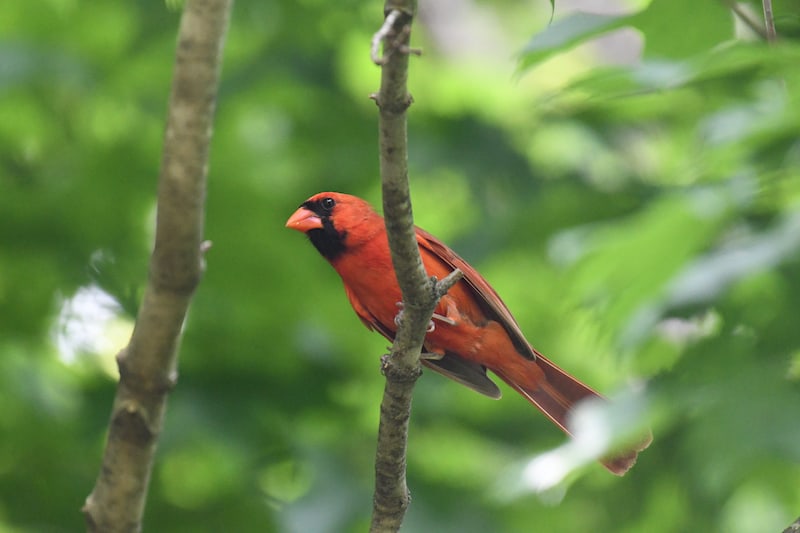
Cardinals are probably on most people’s list as their favorite backyard bird. The Northern Cardinal is a year-round resident of the eastern half of the United States, as well as portions of Canada and Mexico.
They provide beautiful pops of color on gray winter days, and fill the yard with beautiful songs in the spring. If you want to know how to attract cardinals to your yard, then you’re in the right place.
Thankfully, it isn’t too difficult to attract cardinals as they will readily visit bird feeders. But there are a bunch of things you can do to make your yard an even more attractive habitat for them. Perhaps even get them to stay and nest. That’s exactly what we’re going to discuss in this article.

HOW TO ATTRACT CARDINALS
We put together a list of 12 tips for attracting cardinals and providing a good habitat for them.
1. CARDINAL FRIENDLY BIRD FEEDERS
It is true that cardinals will attempt to eat from most types of seed feeders. But they do have favorites. Their slightly larger size can make balancing on the small narrow perches of tube feeders difficult. Cardinals prefer room to maneuver.
Platform feeders are the cardinals favorite. They are natural ground foragers and an open platform replicates that. You can incorporate a platform feeder in a number of ways. A hanging platform is great for feeder poles. You can also find dishes and trays that clamp onto feeder poles.
For 4×4 post feeders, a fly-through platform mounted on top attracts many birds. You can even get a platform that sits on the ground, which could be handy if you don’t have a pole feeder setup.
Feeders that empty into a tray, surrounded by a perch, are also good for cardinals. This “panorama” feeder is a good example. The seed empties into a tray at the bottom with a large continuous perch, rather than having feeding ports along the tube.
If you need to combine squirrel proofing with cardinal friendly, I recommend weight activated feeder. Either of the following feeders are squirrel-proof and cardinals love them.
2. BIRDSEED
Cardinals have thick and strong beaks. This allows them to crack open some of the larger and tougher seeds. Sunflower (striped or black oil) and safflower are favorites.
They can even handle cracked corn. They also enjoy peanut pieces and other nuts. Most birdseed mixes should work fine for cardinals, but I would look for ones with a large percentage of sunflower and lower percent of “filler” seeds like milo and millet. For more information check out our article about best birdseed for cardinals and our complete birdseed guide.
3. REDUCE COMPETITION
Cardinals are actually fairly shy birds. They don’t always enjoy a lot of chaos at the feeder and might hang back if it looks too busy. Having multiple (two or more) feeders in different areas of the yard can give them options. Placing feeders near bushes or trees they can quickly fly to, can also make cardinals feel more secure.
4. KEEP FEEDERS FULL
If you always have food waiting for them when they show up, cardinals will be more likely to keep coming back routinely. Early morning and early evening are supposedly when they visit feeders the most.
Personally I have found early morning to be true. Filling up your feeders at the end of the day so that there is plenty of seed ready in the morning will make your feeders a must-visit stop on their daily route.

5. SHELTER AND NESTING AREAS
Cardinals do not use birdhouses. But you can still provide good nesting spots for them. They like to build their nest in a protected area of thick vegetation.
Dense shrubs and trees are great for this, and they don’t have to be tall. Nests are usually built within 3-15 feet of the ground. A hedge row, cluster of shrubs, evergreen trees or tangle of native vegetation will all do.
Evergreen trees and bushes are great because they not only provide nesting areas, but covered areas of shelter in the winter. Try planting a variety and having some “layers” of shrubs with differing heights. Cardinals build more than one nest per season, and don’t often reuse them, so they are always on the lookout for new spots.
6. NESTING MATERIAL
Female cardinals build the nest. She constructs an open cup shape out of twigs, weeds, pine needles, grass, roots and bark. Then lines the inside of the cup with softer plant material.
You can help cardinals easily find these nesting necessities. If you are trimming shrubs consider leaving some small twigs scattered around. Same with small piles of grass clippings or weeds.
You can also collect these materials and offer them in a more obvious spot. An empty suet cage hung from a tree makes a good holder you can pack with nest building materials.
You can offer twigs, grasses, pine needles, even clean pet hair. Songbird Essentials makes this hanging cage with cotton nesting material that could be used by many birds.
7. WATER
All birds need water for bathing and drinking. Bird baths and water features can be a great way to attract more birds, including cardinals, to your yard. Use de-icers in the winter, and solar fountains in the summer to create an even more inviting experience. Check out our article on how to get birds to use your bird bath for lots of tips!
8. PLANT SOME BERRIES
Cardinals eat plenty of berries. Consider planting some berry producing shrubs and trees in your yard. If you can, plant a few that have berries at different times of year to have food for all seasons. Dogwood, hackberry, mulberry, northern bayberry and serviceberry are good choices.
Did you know carotenoid pigments found in red berries are what help give male cardinals their bright color? Try some red berry producing shrubs such as hawthorn, serviceberry, raspberry, sumac and winterberry. Just remember when planting, it’s always best to stick with what is native to your region.

9. DON’T FORGET PROTEIN
Cardinals may eat plenty of seed, but they also include insects in their diet. They start to eat more insects in the spring and summer. Caterpillars are a favorite, and are something they look for to feed their newly hatched chicks. Encouraging caterpillars in your yard can help provide this food source for them and their babies.
Try planting some caterpillar favorites such as dill, fennel, parsley, coneflower, milkweed, black-eyed susan, aster and vetch. Even just avoiding use of pesticides in your yard can help ensure there are more caterpillars and larvae for the birds to find.
10. DON’T CLEAN UP THOSE PERENNIALS
If you have some perennials that you clip down and clean up at the end of the season, consider leaving them for the winter. As the flowers dry up in autumn they create husks that contain many seeds.
Many wild birds, including cardinals, look for these dried out perennials in the fall and winter to pick through and forage for the seeds. You can always tidy things up in the spring before the new bloom.
11. COVER REFLECTIVE SURFACES
Male cardinals are known for fighting their own reflections. While cardinals hang together in groups during the winter, once spring comes the friendship is over. Males become very territorial and will chase each other off.
If they catch their own reflection they can become confused, believing it is a rival male, and will thrash and bash themselves against it. This wastes their time and energy, not to mention they can hurt themselves.
Check your yard for windows that catch the sun just right to become mirrors. Also look out for any shiny chrome that might be on your yard equipment or garden decorations.
Cover up & move what you can. For windows, these stick-on bird decals can go a long way to break up that mirror effect. As a bonus, they also help prevent accidental window collisions.
12. DON’T FORGET PREDATORS
I am mostly talking about the cat variety here. Outdoor cats love to stalk and kill songbirds. They can’t help it, it’s in their nature. However you can help reduce this risk by making sure your bird feeders are far enough away from areas of ground cover.
Cats will look for low bushes, clusters of tall grasses and crawl space beneath decks to conceal themselves while they get close enough to pounce.
Cardinals especially like to pick through the fallen seed on the ground underneath feeders. This puts them right in the danger zone. Try and keep feeders 10-12 feet away from ground cover. You want to give the cardinals those few extra seconds to see the cat and fly away.
CONCLUSION
These simple tips will help you attract the beautiful Northern Cardinal to your yard. Even just putting out the right type of feeder with some seed they love will be enough to get them interested.
The males don’t their bright color in the winter like goldfinches, and they won’t disappear in the winter like orioles or hummingbirds. I think their consistency is part of their charm. A familiar backyard friend we know is always around.








